PIC LAB-1 Test 2 <!-- Begin var ans = new Array; var done = new Array; var score = 0; ans\[1\] = "A Tuned Circuit"; ans\[2\] = "Rise"; ans\[3\] = "1n"; ans\[4\] = "0.045Amp"; ans\[5\] = "0.1u"; ans\[6\] = "0.001A"; ans\[7\] = "1.2v"; ans\[8\] = "1mA"; ans\[9\] = "Common Collector/Emitter Follower"; ans\[10\] = "B"; ans\[11\] = "The cathode lead is shorter. It goes to the negative rail"; ans\[12\] = "Between 3 and 35mA, depending on the brightness required"; ans\[13\] = "Inverted"; ans\[14\] = "a"; ans\[15\] = "A"; ans\[16\] = "remains constant"; ans\[17\] = "Cathode Ray Oscilloscope"; ans\[18\] = "microfarad, electrolytic, capacitor, picofarad"; ans\[19\] = "5%, 10%, 1%"; ans\[20\] = "a"; ans\[21\] = "p, n, u"; ans\[22\] = "A Schmitt Trigger"; ans\[23\] = "0.1u or 100n - both are correct"; ans\[24\] = "The voltage across the capacitor"; ans\[25\] = "LOW"; function Try(question, answer) { if (answer != ans\[question\]) { if (!done\[question\]) { done\[question\] = -1; window1=window.open("", "NewWindow1", "toolbar=no,directories=no,menubar=no,scrollbars=no,top=475,left=25,width=320,height=20"); window1.document.writeln("<title>Answers to: 25 QUESTIONS . . . . </title>"); window1.document.writeln("<font face=Arial size=2 color=#FF00cc><center>Wrong!\\n\\nYour score is now: " + score + "<font face=Arial size=2 color=#cc0000><center>The correct answer is: <font face=Arial size=2 color=#000000>" + ans\[question\]); } else { alert("You have already answered that question"); } } else { if (!done\[question\]) { done\[question\] = -1; score++; alert("Correct!\\n\\nYour score is now: " + score); } else { alert("You have already answered that question"); } } } function Assessment () { if (score >= 25) { alert("Perfect Score!"); } if (score >= 20 && score <= 29) { alert("Excellent Work - but not Perfect!") } if (score >= 0 && score <= 19) { alert("You need to do the BASIC ELECTRONICS COURSE. \\nYou will be amazed at how much you will learn.") } } // End -->
Answer the following questions … JavaScript is required!
This test sees how much you know about basic electronics.
1. A capacitor and coil in parallel is called:

- A Tuned Circuit
- A Timing Circuit
- A Delay Circuit
- A Schmitt Circuit
2. When the base is raised, the emitter will:
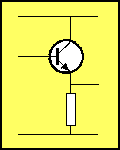
- Rise
- Fall
- Remain Fixed
- Oscillate
3. What is 1,000p?
- 0.01n
- 0.001u
- 0.1n
- 1n
4. The current in a circuit is 45mA. This is:
- 0.045Amp
- 0.00045A
- 0.0045A
- 0.45A
5. A 100n capacitor can be expressed as:
- 0.1u u = microfarad
- 0.01u
- 0.001u
- none of the above
6. 1mA is equal to:
- 0.001A
- 0.00001A
- 0.01A
- 0.1A
7. 1,200mV is equal to:
- 12v
- 1.2v
- 0.12v
- 0.0012v
8. If a 10k resistor is placed across a 10v supply, the current will be:
- 10mA
- 1mA
- 0.01mA
- 0.1mA
9. This arrangement is called:

- Common Emitter
- Common Collector/Emitter Follower
- Common Base
10. Identify the correctly connected LED:
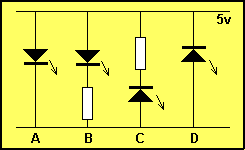
- A
- B
- C
- D
11. Identify the correct statement:

- The cathode lead is longer. It goes to the negative rail
- The cathode lead is shorter. It goes to the negative rail
- The cathode lead is shorter. It goes to the positive rail
- The cathode lead is longer. It goes to the positive rail
12. The current requirement of a LED is:
- 1.7mA
- 25mA
- Between 3 and 35mA
- 65mA
13. The signal at the collector will be …
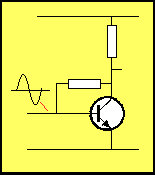
- Inverted …
- In-phase …
… with the base.
14. The purpose of the capacitor:
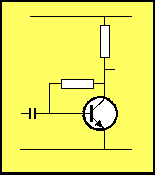
- To pass AC on the input to the base
- To allow the transistor to self-bias
- Block DC from the input line
- To allow the stage to operate
15. The direction of conduction for a diode is:

- A
- B
- C
16. A DC voltage …
- rises and falls
- is a sinewave
- remains constant
- is an audio waveform
17. A CRO is a
- Cathode Ray Oscillator
- Cathode Ray Oscilloscope
- Capacitor-Resistor Oscillator
- Capacitor-Resistor Output
18. These jargon terms mean: (Jargon = language peculiar to a trade)
‘mickey’ ‘electro’ ‘cap’ ‘puff’
- mighty, electronic, capper, picofarad
- microfarad, electronic, capacitor, picofarad
- microfarad, electrolytic, capacitor, picofarad
- microfarad, electrolyte, capping, blow
19. The tolerance bands: gold; sliver; brown, represent:
- 10%, 5%, 1%
- 5%, 10%, 2%
- 5%, 10%, 1%
- 10%, 5%, 2%
20. 223 on a capacitor represents:
- 0.022u u = microfarad
- 22n n = nanofarad
- 22,000p p = picofarad
- All of the above
21. Arrange these in ascending order: n, p, u
- p, u, n,
- n, u, p
- p, n, u
22. Name this symbol:

- A buffer
- A NOR gate
- A NAND gate
- A Schmitt Trigger
23. The number “104” on a capacitor indicates:
- 0.1u
- 100n
- 1n
- 10n
24. What is the multimeter detecting:
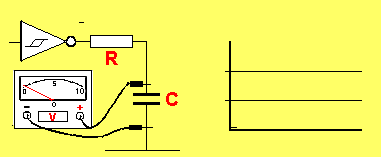
- The output voltage of the Schmitt Trigger
- The delay across the capacitor
- The voltage across the capacitor
- The current through the capacitor
25. For the XOR gate, what is the output when both inputs are HIGH:

- HIGH
- LOW
- Can be HIGH or LOW
- Cannot be determined
These are the types of questions you should be able to answer INSTANTLY, if you want to design and build microcontroller projects. If you get less than 20, now’s the time to do the Basic Electronics Course. Try the test again after the course, I’m sure you will “fly” through the answers and be amazed at how much you have learnt.
Quick Links
Legal Stuff
Social Media


